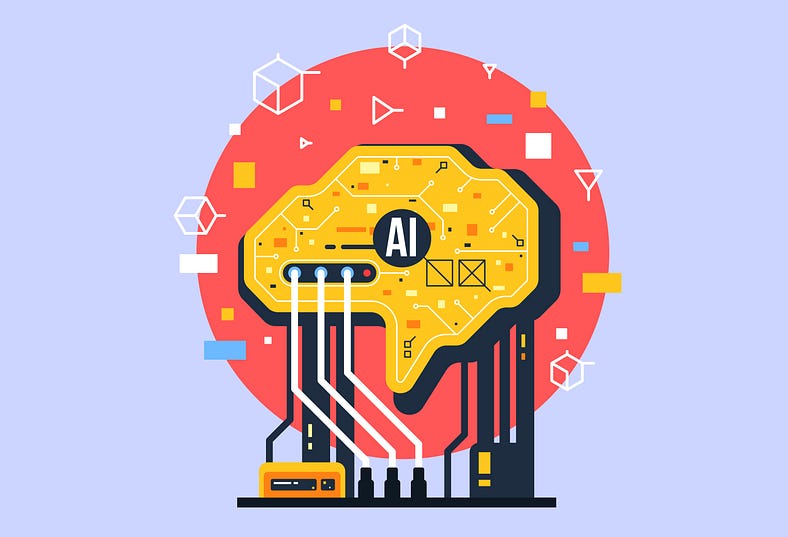
Recursive Neural Networks (RvNNs)
In order to understand Recurrent Neural Networks (RNN), it is first necessary to understand the working principle of a feedforward network. In short, we can say that it is a structure that produces output by applying some mathematical operations to the information coming to the neurons on the layers.
The information received in the Feedforward working structure is only processed forward. In this structure, an output value is obtained by passing the input data through the network. The error is obtained by comparing the obtained output value with the correct values. The weight values on the network are changed depending on the error, and in this way, a model that can give the most accurate result is created.
Non-linear adaptive models that can learn in-depth and structured information are called Recursive Neural Networks (RvNNs). RvNNs were effective in natural language processing for learning sequences and structures of the trees, primarily phrases, and sentences based on word embedding.
RvNN is the connections between neurons are established in directed cycles. These models have however not yet been universally recognized. The key explanation for this is its underlying ambiguity. Not only for being highly complex structures for information retrieval but also because of a costly computational learning period.
RvNN is more of a hierarchy, where the input series actually is without time aspects, but the input must be hierarchically interpreted in a tree-type manner.
Recursive Neural Networks Architecture
The children of each parent node are just a node like that node. RvNNs comprise a class of architectures that can work with structured input. The network looks at a series of inputs, each time at x1, x2… and prints the results of each of these inputs.
This means that the output depends on the number of neurons in each layer of the network and the number of connections between them. The simplest form of a RvNNs, the vanilla RNG, resembles a regular neural network. Each layer contains a loop that allows the model to transfer the results of previous neurons from another layer.
Schematically, RvNN layer uses a loop to iterate through a timestamp sequence while maintaining an internal state that encodes all the information about that timestamp it has seen so far.
This allows us to create recurring models without having to make difficult configuration decisions. We can use the same parameters as input to perform the same tasks at both the input and the hidden level to generate output, but we can also define different parameters for the output position (e.g. the number of inputs and outputs) for user-defined behavior. This can be used in a variety of ways, such as a single layer, multiple layers, or a combination of layers.
The performance, robustness, and scalability of RvNNs are super exciting compared to other types of artificial neural networks since neural networks consist of a series of connections between nodes in a directed graph or a sequence of connected nodes.

To start building the RvNN, we need to set up a data loader and then a few other things, such as the data type and the type of input and output.
Feed-forward networking paradigms are about connecting the input layers to the output layers, incorporating feedback and activation, and then training the construct for convergence. Let us now consider a simple example of a forward-looking neural network in the perceptron that begins with a very simple concept. The layered topology of the multi-layered perceptron is preserved, but each element has a single feedback connection to another element and weighted connections to other elements within the architecture.
This means that conventional baking propagation will not work, and this leads to the challenge of disappearing gradients. Not all connections are trained, but some are employed, which means that they will work, but not all, leading to a challenge with decreasing gradients.
One of the early solutions of RvNNs was to skip the training of the recurring shift altogether by initializing it before performing it. Since the system is very unstable, we chose a recurring feedback parameter for initialization, while adding a simple linear layer to the output.
In this way, it is possible to perform reasonably well for many tasks and, at the same time, to avoid having to deal with the diminishing gradient problem by completely ignoring it. Learning is limited to the last linear level, so it is much more efficient than the first, but not as fast.
PyTorch is a dynamic framework that can be implemented in a simple Python loop to make learning reinforcements much more efficient. When dealing with RvNNs, they show the ability to deal with different types of input and output, but not always in the same way.
Although recursive neural networks are a good demonstration of PyTorch’s flexibility, it is not a fully-featured framework. The framework combines a GPU accelerated backend library with an intuitive Python frontend that focuses on deep learning, machine learning, and deep neural network processing.
Recurrent Neural Networks (RNNs)
On the other hand, RNNs are a subset of neural networks that normally process time-series data and other sequential data. An RNN is a class of neural networks that are able to model the behavior of a large number of different types, such as humans and animals. So far, models that use structural representation based on an analysis tree have been successfully applied to a wide range of tasks, from speech recognition to speech processing to computer vision.
Recurrent Neural Networks Architecture
The RNNs recalls the past and options based on what you have remembered from the past. Although RNNs still learn during preparation, they bear in mind items that have been learned from previous input(s) during output development.
The input samples containing more interdependent compounds are usually given to the RNNs. They still have a vital role to play in holding details about previous measures. The performance generated at t1 influences the usable parameter at t1 + 1. RNNs thus maintains two types of data, for example, the current and previous recent, such that the outcome for the new data is generated. RNNs also face the loss issue like deep autoencoders.
Libraries;
- Apache Singa
- Caffe: Created by the Berkeley Vision and Learning Center (BVLC). It supports both CPU and GPU. Developed in C++, and has Python and MATLAB wrappers.
- Chainer: The first stable deep learning library that supports dynamic, define-by-run neural networks. Fully in Python, production support for CPU, GPU, distributed training.
- Deeplearning4j: Deep learning in Java and Scala on multi-GPU-enabled Spark. A general-purpose deep learning library for the JVM production stack running on a C++ scientific computing engine. . Allows the creation of custom layers. Integrates with Hadoop and Kafka.
- Dynet: The Dynamic Neural Networks toolkit.
- Flux: includes interfaces for RNNs, including GRUs and LSTMs, written in Julia.
- Keras: High-level, easy to use API, providing a wrapper to many other deep learning libraries.
- Microsoft Cognitive Toolkit
- MXNet: a modern open-source deep learning framework used to train and deploy deep neural networks.
- Paddle Paddle (https://github.com/paddlepaddle/paddle): PaddlePaddle (PArallel Distributed Deep LEarning) is a deep learning platform, which is originally developed by Baidu scientists and engineers for the purpose of applying deep learning to many products at Baidu.
- PyTorch: Tensors and Dynamic neural networks in Python with strong GPU acceleration.
- TensorFlow: Apache 2.0-licensed Theano-like library with support for CPU, GPU, and Google’s proprietary TPU,[84] mobile
- Theano: The reference deep-learning library for Python with an API largely compatible with the popular NumPy library. Allows the user to write symbolic mathematical expressions, then automatically generates their derivatives, saving the user from having to code gradients or backpropagation. These symbolic expressions are automatically compiled to CUDA code for a fast, on-the-GPU implementation.
- Torch (www.torch.ch): A scientific computing framework with wide support for machine learning algorithms, written in C and lua. The main author is Ronan Collobert, and it is now used at Facebook AI Research and Twitter.
Cited Sources
- https://dl.acm.org/doi/10.5555/2969033.2969061
- https://maryambafandkar.me/recursive-neural-network-vs-recurrent-neural-network/
- https://missinglink.ai/guides/neural-network-concepts/recurrent-neural-network-glossary-uses-types-basic-structure/
- https://machinelearningmastery.com/recurrent-neural-network-algorithms-for-deep-learning/
- https://vinodsblog.com/2019/01/07/deep-learning-introduction-to-recurrent-neural-networks/
- https://www.tensorflow.org/guide/keras/rnn
- https://blog.exxactcorp.com/5-types-lstm-recurrent-neural-network/
- https://www.geeksforgeeks.org/introduction-to-recurrent-neural-network/
- https://devblogs.nvidia.com/recursive-neural-networks-pytorch/
- https://en.wikipedia.org/wiki/Recursive_neural_network
- https://en.wikipedia.org/wiki/Recurrent_neural_network
